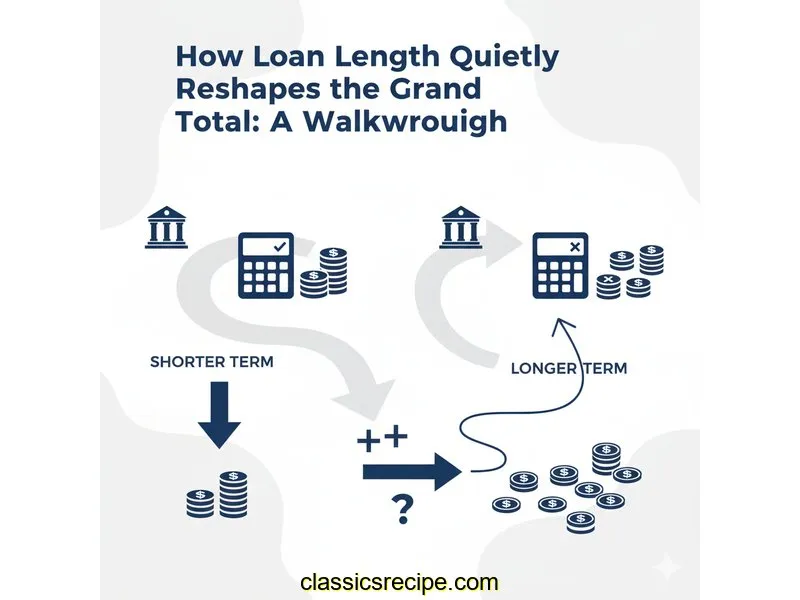
Auto Loan Calculator
Calculate payments over the life of your Loan
Home Blog Privacy Terms About Contact
Calculate payments over the life of your Loan
Home Blog Privacy Terms About ContactPublished on October 15, 2025

My journey into the world of loan math began not with a need for a loan, but with a conversation. A friend was thrilled about a recent vehicle purchase, specifically mentioning their manageable monthly payment. I knew the vehicle they got was similar in price to one I had been looking at hypothetically, but their monthly obligation was nearly a hundred dollars less than what I had seen in my own rough estimates. My first reaction was simple curiosity. How was that possible?
I wasn’t trying to judge their financial choice, but the numbers themselves presented a puzzle I felt compelled to solve. Did they secure a much better interest rate? Put more money upfront? Or was there another variable at play that I was completely overlooking? This wasn't about finding a "deal"; it was about understanding the mechanics. How could two similar loan amounts result in such distinct monthly outflows? What piece of the puzzle was I missing?
My initial attempts to unravel this involved plugging numbers into a few online loan tools. I would input a loan amount, guess at an interest rate, and then play with the loan term. I saw the payment number go up and down as I adjusted the term, but I didn't truly grasp the significance. I was just observing a phenomenon without understanding the underlying mechanism. My focus was entirely on that one output: the monthly payment. It felt like watching a magic trick without knowing the secret.
This whole exploration is purely about my quest to understand how the calculations work and how these online tools function. It's a documentation of my learning process. This is about understanding how calculations work, not financial advice. My goal was simple: to build the literacy to see not just the monthly number, but the entire story the numbers were telling.
My initial confusion was rooted in a very specific, and I now realize, very common oversight. I was fixated on the wrong number. When I started plugging my hypothetical scenario into a loan tool—let's say for a principal of $18,350 at a 6.8% annual rate—I saw exactly what my friend was talking about. The tool immediately presented me with options, and my eyes went straight to the smallest monthly payment.
For instance, when I set the term to 72 months, the tool showed a monthly payment of around $309.84. That number seemed very approachable. It was low, predictable, and easy to imagine fitting into a budget. In my mind, a lower payment felt like a "win." It seemed like the most efficient way to borrow because it demanded less from my cash flow each month. I thought I had solved the puzzle; my friend must have just chosen a longer repayment period.
But something still felt off. I then adjusted the term to 48 months, just to see the contrast. The calculator updated instantly, showing a new monthly payment of approximately $436.87. My immediate reaction was a sense of sticker shock. Why would anyone choose to pay over $120 more every single month if they didn't have to? It seemed illogical. My entire analysis was based on this single data point. I was looking at two scenarios and judging them solely on their monthly impact.
The frustration wasn't with the tool; it was with my own understanding. I knew that the two outcomes originated from the same loan amount and interest rate. The only variable I manipulated was time. How could time alone create such a vast gulf in monthly obligations? And more importantly, was the monthly payment truly the only measure of a loan's structure? I had a nagging feeling that I was only reading the first chapter of a much longer book and that the real story was hidden in the other output fields I had been completely ignoring.
The breakthrough moment arrived when I consciously decided to ignore the monthly payment field. I forced myself to look at every other piece of data the online tool was showing me. My eyes scanned past the familiar numbers and landed on a section often labeled something like "Total Interest Paid" and "Total of All Payments." It was here, in these less-prominent fields, that the entire narrative was waiting for me.
I ran my two scenarios again, side-by-side, but this time I recorded all the outputs. The numbers were startling and instantly illuminated what I had been missing. The lower monthly payment wasn't a magic trick; it was a trade-off. A very significant trade-off, at that. Seeing the complete set of numbers laid out finally connected all the dots for me. The secret wasn't in some complex financial wizardry but in simple, transparent arithmetic I hadn't bothered to examine.
The first step in my newfound clarity was focusing on the grand total. This number represents every single dollar that leaves your pocket over the life of the loan. It's the original principal plus all the interest combined. Seeing that the 72-month term led to a grand total of $22,308.48, while the 48-month term resulted in $20,969.76, was a profound moment. The seemingly small monthly payment had a huge downstream impact.
To solidify my understanding, I did the math myself. For the 72-month scenario, I multiplied the monthly payment by the term: $309.84 x 72 months = $22,308.48. For the 48-month one: $436.87 x 48 months = $20,969.76. The numbers matched the calculator's output perfectly. This simple act of verification moved the concept from abstract to concrete. It wasn't just a number on a screen; it was a calculation I could replicate.
With this new knowledge, I could finally articulate the trade-off. The lower monthly payment was "purchased" at the price of paying an additional $1,338.72 in interest over the life of the loan. This wasn't good or bad; it was simply a mechanical relationship between the variables. Understanding this relationship was the key to my entire learning journey. The monthly payment speaks to affordability, while the total interest speaks to the overall expense.
To be absolutely sure I understood the principle, I ran a third test. I chose a middle ground: a 60-month term. The calculator produced a monthly payment of about $359.13 and total interest of $3,197.80. As I expected, both numbers fell perfectly between the 48-month and 72-month scenarios. This confirmed the pattern: as the term gets longer, the monthly payment shrinks, but the total interest paid grows. I finally had the full picture.
This whole exercise has fundamentally altered how I look at loan calculations. My perspective has shifted from a narrow focus on one number to a broader appreciation for how all the numbers interact. It's like learning to read a whole dashboard instead of just staring at the speedometer. Here are the main lessons I've internalized about the mechanics of these calculations.
From what I've learned, the term has a direct and significant influence. A longer term means you are making payments for more months. While each payment is smaller, the interest has more time to accrue on the outstanding balance. So, even if the interest rate is the same, stretching out the payments almost always leads to a higher amount of total interest paid, and therefore a higher grand total.
My journey showed me that a lower monthly payment is often achieved by lengthening the repayment period. It makes the loan more manageable on a month-to-month basis, but it's a trade-off. By extending the term, you increase the total number of payments and the total interest that accrues, which raises the overall expense of the loan.
In my experience, looking at the "Total of All Payments" (or a similarly named field) is the most revealing. This single number tells you the full story: the original amount you borrowed plus all the interest you will pay over the entire term. It helps to see beyond the monthly payment and understand the complete financial commitment.
Yes, and doing so was a huge help for my own understanding. First, calculate the "Total of All Payments" by multiplying the monthly payment by the number of months in the term. Then, subtract the original loan principal from that total. The result should be the total interest paid. For example: ($309.84 payment x 72 months) - $18,350 principal = $3,958.48 in total interest.

My biggest takeaway from this entire process is simple: the story of a loan is told by all of its numbers, not just one. My initial fixation on the monthly payment was like trying to understand a movie by watching only a single scene. It was completely out of context. By taking a step back and learning to read all the outputs from a loan calculator, I feel like I can now see the entire plot.
I didn't uncover some secret or find a trick. I just learned to look at the math that was there all along. The relationship between term, payment, and total interest isn't an opinion; it's a mechanical reality of how these calculations work. Playing with the numbers myself, verifying the outputs, and seeing the patterns emerge gave me a sense of confidence that I didn't have before.
I would encourage anyone who feels intimidated by these topics to open an online calculator and just start exploring. Don't worry about making the "right" choice. Instead, focus on understanding how adjusting one input reshapes all the others. For me, that simple act of curiosity turned confusion into clarity.
This article is about understanding calculations and using tools. For financial decisions, always consult a qualified financial professional.
Disclaimer: This article documents my personal journey learning about loan calculations and how to use financial calculators. This is educational content about understanding math and using tools—not financial advice. Actual loan terms, rates, and costs vary based on individual circumstances, creditworthiness, and lender policies. Calculator results are estimates for educational purposes. Always verify calculations with your lender and consult a qualified financial advisor before making any financial decisions.
